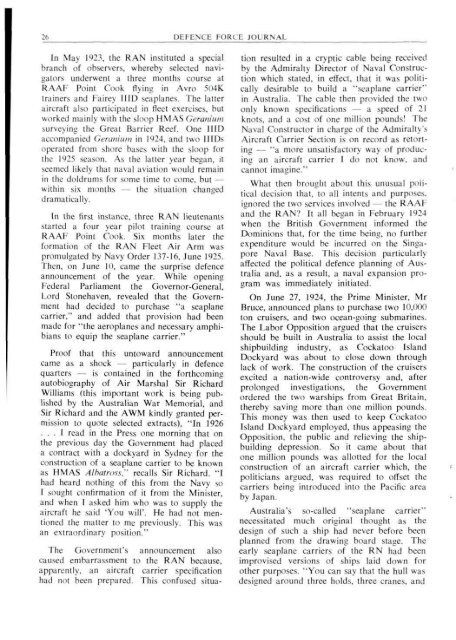ISSUE 3 : Mar/Apr - 1977 - Australian Defence Force Journal
ISSUE 3 : Mar/Apr - 1977 - Australian Defence Force Journal
ISSUE 3 : Mar/Apr - 1977 - Australian Defence Force Journal
You also want an ePaper? Increase the reach of your titles
YUMPU automatically turns print PDFs into web optimized ePapers that Google loves.
26 DEFENCE FORCE JOURNALIn May 1923, the RAN instituted a specialbranch of observers, whereby selected navigatorsunderwent a three months course atRAAF Point Cook flying in Avro 504Ktrainers and Fairey HID seaplanes. The latteraircraft also participated in fleet exercises, butworked mainly with the sloop HMAS Geraniumsurveying the Great Barrier Reef. One HIDaccompanied Geranium in 1924, and two 11 IDsoperated from shore bases with the sloop forthe 1925 season. As the latter year began, itseemed likely that naval aviation would remainin the doldrums for some time to come, but —within six months - the situation changeddramatically.In the first instance, three RAN lieutenantsstarted a four year pilot training course atRAAF Point Cook. Six months later theformation of the RAN Fleet Air Arm waspromulgated by Navy Order 137-16, June 1925.Then, on June 10, came the surprise defenceannouncement of the year. While openingFederal Parliament the Governor-General,Lord Stonehaven, revealed that the Governmenthad decided to purchase "a seaplanecarrier," and added that provision had beenmade for "the aeroplanes and necessary amphibiansto equip the seaplane carrier."Proof that this untoward announcementcame as a shock — particularly in defencequarters — is contained in the forthcomingautobiography of Air <strong>Mar</strong>shal Sir RichardWilliams (this important work is being publishedby the <strong>Australian</strong> War Memorial, andSir Richard and the AWM kindly granted permissionto quote selected extracts), "In 1926... I read in the Press one morning that onthe previous day the Government had placeda contract with a dockyard in Sydney for theconstruction of a seaplane carrier to be knownas HMAS Albatross," recalls Sir Richard. "Ihad heard nothing of this from the Navy soI sought confirmation of it from the Minister,and when I asked him who was to supply theaircraft he said 'You will'. He had not mentionedthe matter to me previously. This wasan extraordinary position."The Government's announcement alsocaused embarrassment to the RAN because,apparently, an aircraft carrier specificationhad not been prepared. This confused situationresulted in a cryptic cable being receivedby the Admiralty Director of Naval Constructionwhich stated, in effect, that it was politicallydesirable to build a "seaplane carrier"in Australia. The cable then provided the twoonly known specifications --a speed of 21knots, and a cost of one million pounds! TheNaval Constructor in charge of the Admiralts'sAircraft Carrier Section is on record as retorting— "a more unsatisfactory way of producingan aircraft carrier I do not know, andcannot imagine."What then brought about this unusual politicaldecision that, to all intents and purposes,ignored the two services involved — the RAAFand the RAN? It all began in February 1924when the British Government informed theDominions that, for the time being, no furtherexpenditure would be incurred on the SingaporeNaval Base. This decision particularlyaffected the political defence planning of Australiaand, as a result, a naval expansion programwas immediately initiated.On June 27, 1924, the Prime Minister, MrBruce, announced plans to purchase two 10,000ton cruisers, and two ocean-going submarines.The Labor Opposition argued that the cruisersshould be built in Australia to assist the localshipbuilding industry, as Cockatoo IslandDockyard was about to close down throughlack of work. The construction of the cruisersexcited a nation-wide controversy and, afterprolonged investigations, the Governmentordered the two warships from Great Britain,thereby saving more than one million pounds.This money was then used to keep CockatooIsland Dockyard employed, thus appeasing theOpposition, the public and relieving the shipbuildingdepression. So it came about thatone million pounds was allotted for the localconstruction of an aircraft carrier which, thepoliticians argued, was required to offset thecarriers being introduced into the Pacific areaby Japan.Australia's so-called "seaplane carrier"necessitated much original thought as thedesign of such a ship had never before beenplanned from the drawing board stage. Theearly seaplane carriers of the RN had beenimprovised versions of ships laid down forother purposes. "You can say that the hull wasdesigned around three holds, three cranes, and
















